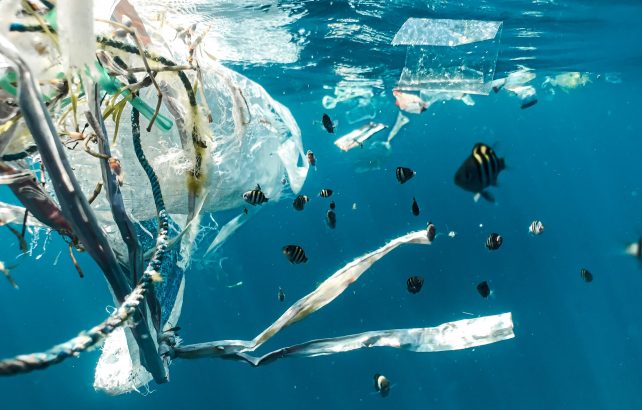Professor Eglė Lastauskienė: “There Is No Place on Earth Where Microplastics Are Not Found”
 Although tiny pieces of microplastics cannot be seen with the naked eye, scientists are finding them everywhere: in water bodies, in natural environments, in the soil, in foodstuffs and even in the human body. There is a particular concern that microplastics are being found in the blood.
Although tiny pieces of microplastics cannot be seen with the naked eye, scientists are finding them everywhere: in water bodies, in natural environments, in the soil, in foodstuffs and even in the human body. There is a particular concern that microplastics are being found in the blood.
According to Prof. Eglė Lastauskienė, a researcher at the Vilnius University Life Sciences Centre (VU GMC), the detection of microplastics in the blood is a very bad sign that microplastics are being taken up by the body’s cells and can be spread to all our organs. In the VU podcast, she talks about the difficulties in detecting microplastics, their potential danger to the environment and the human body, and the micro-organisms that VU scientists are looking for in order to degrade these plastics.
What are microplastics and nanoplastics? Where do they come from?
Microplastics are the same plastics we use every day but broken down into tiny particles that we can’t see. Microplastics are plastics that are half a millimetre or smaller in size. Nanoplastics are formed when microplastics are broken down into even smaller particles, which are so fine that they can get everywhere. All plastics pose a certain risk, as they tend to degrade into microplastics over time.
How do plastics enter living organisms?
As microplastics are very small particles, it is not difficult for them to enter into living organisms. Microplastics can even be accumulated by plants that suck them up through their roots, and then by living organisms that feed on those plants that have accumulated microplastics. A common example is fish that feed on sediment. This is how microplastics enter the food chain and start accumulating, and how people absorb microplastics when they consume this food. We can also breathe in microplastics, just like dust, allowing them to enter the lungs, then the bloodstream and travel to other organs.
Is this dangerous?
Currently, we don’t have much data on the health dangers of plastics. Isolated articles have appeared, but the scientific literature has not yet confirmed that plastics have any toxic properties. However, various particles such as heavy metals, pesticides and toxic compounds can easily stick to plastic. This may not pose a high potential risk in itself, but these compounds can be carriers of toxic substances, and liver damage has already been observed in laboratory animals. Microplastics can accumulate in any organ where they are deposited and where it is easy for them to take root.
Where are microplastics most prevalent, and how can they be avoided?
The scary thing is that microplastics are impossible to avoid, just like pollen in the spring. They are found in insane amounts in water, air and a wide range of soils. In fact, new data shows that there is no longer any place on earth where microplastics are not found. This means that scientists no longer have a control zone – a clean place.
Can we replace the use of plastic with something else?
It probably won’t be possible to change the use of plastics in every case. However, the plastics used in processing plants are now different, last longer and produce much less waste.
Moreover, if we reduce the use of plastics in our daily lives, for example, by eliminating plastic packaging, plastic waste would definitely decrease. What we generate every day, and every one of us is a major source of pollution.
What can be done about microplastics? Is it possible to reduce their level in the environment?
It is currently impossible to remove plastics mechanically by cleaning up a reservoir or an area of soil. But this is where micro-organisms can help by breaking down the products we throw away. Areas contaminated with plastics or oil are home to micro-organisms that are able to take up these materials as a carbon source and use them as food.
That is why the search for micro-organisms or enzymes that can help remove plastics from the environment is now underway. Unfortunately, such micro-organisms cannot eat the vast quantities we produce. This means we need to provide them with better conditions or qualities so that they can thrive in a particular environment and absorb more plastic.
Hypothetically, suppose an efficient bacteria that remove one or another type of plastic is discovered. In that case, they could be made to reproduce, and perhaps by filling a landfill with those bacteria, they could recycle all the plastic waste in just a few weeks. Another option is to produce enzymes that, when applied to plastic deposits under certain conditions, will not allow them to remain in the environment. However, enzymes are more complicated, as each has its own optimum temperature and pH spectrum in which it will work. Thus, if we were to pour them into a landfill, we would certainly not be able to maintain all the parameters needed for the enzyme activity.
If an effective micro-organism could be found in Lithuania, it would work not only in our country but also in neighboring countries with similar natural conditions.
How far have these studies advanced?
The Life Sciences Centre has several research groups working on plastics. But even if we find a micro-organism that grows on plastic, it is very difficult to apply it to real systems. This is because the genes that work in one micro-organism stop working in others because they need certain regulators or activators.

Another important factor is the detection of microplastics or nanoplastics. These are often colorless filaments and follicles that are difficult to detect, even in a specific environment. This makes it difficult to assess whether we already have a micro-organism that has reduced the amount of microplastics, as we don’t know how much microplastic was there beforehand. It is therefore important for scientists that a globally validated methodology – a gold standard – emerges to establish whether the technology works or not.
How do you search for micro-organisms that degrade microplastics?
We bring a soil sample into the lab, grow the bacteria and purify the media so that the only carbon source is plastic. This means the bacteria that remain are able to grow in an environment where there is no other source of carbon, with a high probability of breaking down the plastic and taking it up as carbon.
Are the effects of microplastics on living organisms being studied?
Intensive research is being conducted on the effects of microplastics in laboratory animals. Although there is no evidence yet that plastic causes toxic effects, its detection in the blood or other body fluids is a terrible sign, because it means that the cells are able to take up the plastic and pass it on to the bloodstream.
Microplastics are molecules that are foreign to our body and their presence can trigger an immune reaction. This constant state of tension, when something that the immune cells cannot recognise is circulating in the body, is dangerous not from a medical point of view, but concerning the body’s reaction.
Even if scientists could find a way to remove microplastics from the environment by breaking them down with bacteria, would it still be impossible to remove them from the human body?
This is very complicated. We don’t know how much our microbiota (the collection of micro-organisms in the body) can do. Of course, our micro-organisms protect us from a wide range of foreign organisms from outside the body. But it is not clear how far they could tackle this problem, as very few studies have been completed.
Are microplastics even more dangerous in ocean ecosystems than they are for humans?
Yes, the ocean ecosystem is at great risk, as not only microplastics but also macroplastics are causing terrible damage to all marine animals. The marine environment was the first place where the dangers and harm caused by microplastics were identified. From the marine environment, research has moved on to the soil, air, and other systems. That’s because plastics wash ashore from the oceans, travel thousands of kilometres with the air masses and even pollute the top of Mount Everest.